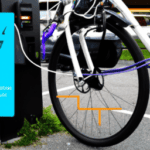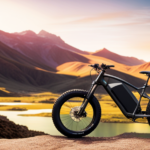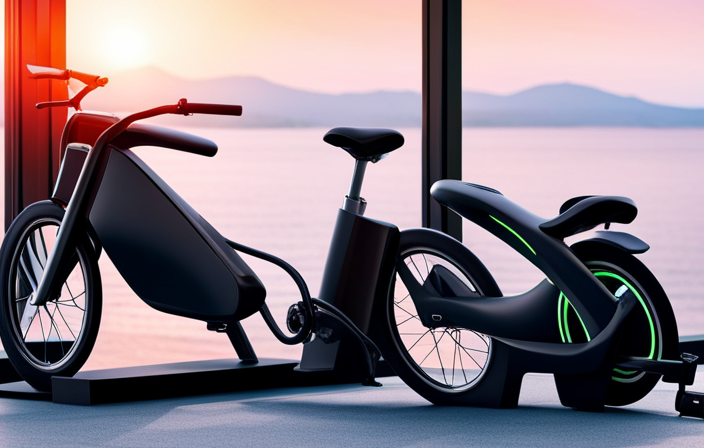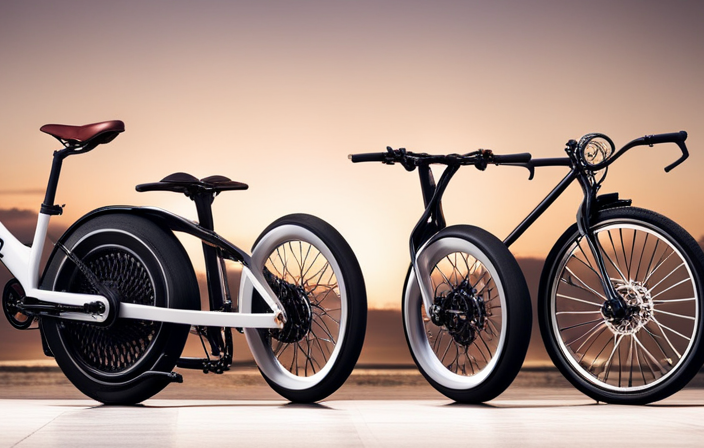How long does a charge last on an electric bike?
Are you tired of constantly worrying about running out of battery power during your rides?
In this article, I will dive into the technical aspects of electric bike batteries and provide you with valuable insights on maximizing battery life and extending your bike’s range.
Additionally, I will share tips for prolonging battery life and give you an overview of battery maintenance and warranty options.
Get ready to ride longer and worry-free!
Key Takeaways
- Battery life on an electric bike depends on factors such as capacity, motor power, terrain, and rider weight.
- Higher capacity batteries generally offer a longer range, allowing for more extended trips.
- Charging the battery after each ride helps maintain a consistent charge level and extends battery lifespan.
- Using the correct charger for your specific battery type is essential for optimal performance and longevity.
Types of Electric Bike Batteries
How long does a charge typically last on my electric bike’s battery?
Well, it depends on the type of battery your electric bike is equipped with. There are several electric bike battery technologies available in the market, each with its own pros and cons.
The most common types include lithium-ion, lead-acid, and nickel-metal hydride batteries.
Lithium-ion batteries are known for their high energy density, allowing them to provide longer ride times. Lead-acid batteries are more affordable but have a shorter lifespan and are heavier. Nickel-metal hydride batteries offer a balance between cost and performance.
When considering which battery type to choose, it’s important to weigh factors such as weight, cost, and lifespan. Understanding these different battery types and their characteristics is crucial in determining how long your electric bike’s charge will last.
Now let’s explore the factors that can affect battery life.
Factors Affecting Battery Life
To maximize your battery life on an e-bike, you should consider various factors.
The charging time of an electric bike can be affected by several factors, including the type of battery, the charger used, and the capacity of the battery.
Additionally, the terrain you ride on can have a significant impact on the battery life. Riding on hilly or uneven terrain requires more power from the motor, which drains the battery faster. On the other hand, riding on flat or smooth terrain allows the battery to last longer.
It is also important to note that the weight of the rider and any additional cargo can affect the battery life.
Considering these factors will help you make the most out of your e-bike’s battery.
Moving on to the next section about battery capacity and range, it is important to understand the relationship between these factors.
Battery Capacity and Range
When discussing battery capacity and range for electric bikes, it’s essential to understand watt-hours (Wh).
Watt-hours represent the energy capacity of a battery and determine how far you can travel on a single charge.
Different battery capacities will result in varying average ranges, with higher capacities providing a longer range.
Additionally, range extenders and spare batteries can be used to increase the distance you can travel, allowing for more flexibility and convenience during longer rides.
Understanding Watt-hours (Wh)
Understanding Watt-hours (Wh) will help you determine how long a charge will last on your electric bike. Watt-hours is a unit of energy that represents the amount of power a battery can deliver over a certain period of time. By understanding battery efficiency and calculating battery range, you can estimate the distance you can travel on a single charge.
To calculate battery range, divide the battery’s watt-hour rating by the average power consumption of your electric bike. This will give you an approximate range in kilometers or miles. Knowing the watt-hour rating of your battery is crucial in determining the range of your electric bike.
In the next section, we will explore the average range for different battery capacities, providing a deeper understanding of how long your electric bike can last on a single charge.
Average Range for Different Battery Capacities
The average range you can expect for different battery capacities will give you a better idea of how far you can travel on a single charge. Electric bike battery efficiency plays a crucial role in determining the range. Higher capacity batteries typically have a longer range, as they can store more energy.
However, it’s important to consider that the range can be affected by various factors such as terrain and riding style. Riding on hilly terrains or using excessive power can significantly reduce the battery range. Additionally, headwinds and rough surfaces can also impact the overall efficiency of the battery.
It’s essential to keep these factors in mind when estimating the range of your electric bike. Understanding the impact of terrain on battery range can help you make informed decisions about your travel plans.
Moving on to range extenders and spare batteries, they provide additional options for extending your electric bike’s range.
Range Extenders and Spare Batteries
If you want to increase your range, range extenders and spare batteries are great options to consider. Range extender options are available for electric bikes and can greatly extend your riding distance. These devices are typically compact and easy to install, allowing you to carry extra power with you on longer rides. They can provide an additional boost to your battery’s capacity, giving you more time on the road.
On the other hand, spare batteries offer the advantage of a quick and easy swap when your primary battery runs out of juice. You can carry a fully charged spare battery with you and switch them out when needed, allowing you to continue riding without any downtime. These options can significantly enhance your electric bike experience, giving you the freedom to explore longer distances.
Now, let’s move on to how to maximize battery life.
How to Maximize Battery Life
To maximize battery life on an electric bike, it’s important to follow proper charging and storage practices. Here are some tips to help you maximize battery efficiency and optimize power usage:
-
Charge your battery regularly: Keeping your battery charged between 20% and 80% can help prolong its lifespan.
-
Avoid extreme temperatures: Extreme heat or cold can negatively impact battery performance, so try to store and charge your bike in moderate temperatures.
-
Use the right charger: Always use the charger specifically designed for your electric bike to ensure proper and efficient charging.
By following these guidelines, you can extend the life of your electric bike’s battery and ensure optimal performance.
In the next section, we will discuss how to extend your electric bike’s range even further without compromising battery life.
How to Extend Your Electric Bike’s Range
To maximize the battery life of your electric bike, we discussed some valuable tips in the previous section. Now, let’s delve into how you can extend your electric bike’s range even further. Increasing efficiency is key to getting more out of your battery. One effective way to achieve this is through regenerative braking. This innovative feature converts the energy generated while braking into electricity and stores it back into the battery. It’s like giving your bike a little boost with every stop you make. Additionally, maintaining proper tire pressure, reducing wind resistance, and using pedal assist wisely can all contribute to extending your bike’s range. By implementing these strategies, you can make the most out of your electric bike’s battery and enjoy longer rides. Now, let’s explore the next section on battery life expectancy.
Battery Life Expectancy
You can expect the battery of your e-bike to have a certain lifespan. The battery life expectancy is influenced by several factors, including your charging habits and battery degradation over time.
Charging habits play a significant role in determining how long your battery will last. It is essential to follow the manufacturer’s instructions for charging your e-bike battery properly. Overcharging or undercharging can lead to premature degradation of the battery.
Additionally, extreme temperatures can also affect battery life. It is advisable to store and charge your e-bike battery in a cool, dry place.
To prolong your battery life, consider implementing certain tips such as avoiding deep discharges and charging your battery after every ride. These practices can help maximize the lifespan of your e-bike battery without compromising its performance.
Tips for Prolonging Battery Life
To prolong the battery life of an electric bike, it is crucial to avoid full discharges as much as possible. Keeping the battery charged between 20% and 80% will help maintain its overall health.
Using the correct charger that is specifically designed for your electric bike is essential to prevent any damage to the battery.
Lastly, regularly updating the firmware of your electric bike can optimize its performance and efficiency, ultimately prolonging the battery life.
Avoiding Full Discharges
Avoiding full discharges can help prolong the lifespan of the battery on an electric bike. By avoiding deep discharges, where the battery is completely drained, you can prevent the battery from being strained and increase its overall longevity.
Partial charging is recommended as it keeps the battery at a higher charge level, reducing stress on the cells. This practice also helps prevent the battery from entering a deeply discharged state, which can be detrimental to its performance and capacity. Additionally, partial charging allows for more frequent opportunities to balance the individual cells, ensuring they are all equally charged. This balancing process helps maintain the overall health and efficiency of the battery.
By avoiding full discharges and opting for partial charging, you can significantly extend the lifespan of your electric bike’s battery.
To further optimize the battery’s performance, it is important to keep it charged and maintained properly.
Keeping the Battery Charged
Keeping the battery properly maintained is crucial for optimal performance.
When it comes to bike battery maintenance, there are a few charging best practices to keep in mind.
First, it is important to avoid overcharging the battery. Once it reaches a full charge, it is recommended to unplug it from the charger to prevent any potential damage.
Additionally, it is advisable to charge the battery after each ride, even if it is not completely depleted. This helps to maintain a consistent charge level and prolong the overall lifespan of the battery.
Lastly, it is important to use the correct charger for your electric bike. Using the wrong charger can lead to improper charging, which can negatively affect the battery’s performance.
By following these charging best practices, you can ensure that your electric bike battery lasts longer and performs optimally.
Using the Correct Charger
Make sure you use the right charger for your e-bike to ensure proper charging and optimal performance. Using a universal charger may seem convenient, but it can actually harm your battery and reduce its lifespan. Here’s why it’s important to use the correct charger:
-
Voltage and Current: Each battery type requires a specific voltage and current for charging. Using the wrong charger can either overcharge or undercharge your battery, leading to performance issues and decreased battery life.
-
Safety: Using the wrong charger can pose safety risks, such as overheating or even causing the battery to explode. The correct charger is designed to provide the right amount of power without any hazards.
-
Charging Time: Different battery types have different charging times. Using the correct charger ensures that your battery charges efficiently within the recommended timeframe, allowing you to get back on the road quickly.
-
Battery Lifespan: Incorrect charging can significantly impact your battery’s lifespan. By using the correct charger, you can extend the overall lifespan of your e-bike battery.
To ensure your e-bike performs optimally, it’s crucial to use the right charger. Additionally, regularly updating firmware is another important step in maintaining your e-bike’s performance and longevity.
Regularly Updating Firmware
To ensure optimal performance, it’s important that you regularly update your e-bike’s firmware. Updating the firmware provides several benefits, including improved battery life, enhanced performance, and the addition of new features. The firmware update process is relatively straightforward. First, you need to check if there is a new firmware version available for your electric bike model. This can usually be done through the manufacturer’s website or an app specifically designed for your e-bike. Once you have identified the latest firmware version, you will need to download it onto your computer or smartphone and connect your e-bike to the device. Follow the instructions provided by the manufacturer to complete the firmware update. By keeping your e-bike’s firmware up to date, you can ensure that it operates at its best and enjoy a longer-lasting charge. Speaking of charge, let’s now discuss battery maintenance and care.
Battery Maintenance and Care
You should regularly check and maintain the battery of your electric bike to ensure its longevity. Proper battery maintenance and care are crucial for maximizing the lifespan of your electric bike’s battery.
Here are three important aspects to consider:
-
Battery storage: When not in use, store your electric bike’s battery in a cool and dry place. Extreme temperatures can negatively impact the battery’s performance and lifespan.
-
Battery charging techniques: Follow the manufacturer’s guidelines for charging your electric bike’s battery. Avoid overcharging or leaving it plugged in for too long, as this can degrade the battery’s capacity over time.
-
Battery maintenance: Regularly inspect the battery for any signs of damage or wear. Clean the battery terminals and connections to ensure a secure and efficient connection.
Taking these steps will help maintain the health of your electric bike’s battery.
Now, let’s move on to discussing battery warranty and support.
Battery Warranty and Support
Ensure that your electric bike’s battery warranty and support options are thoroughly understood and readily available. It is important to have a clear understanding of the warranty coverage for your battery, including the duration and any specific conditions that may apply.
Additionally, familiarize yourself with the support options provided by the manufacturer or retailer in case you encounter any issues with your battery. Knowing the battery performance expectations and having access to a troubleshooting guide can be extremely helpful in maximizing the lifespan and efficiency of your electric bike’s battery.
By following the recommended maintenance and care guidelines, you can ensure optimal battery performance.
In the subsequent section about the comparison of electric bike battery life, we will explore the different factors that can affect the duration of a charge.
Comparison of Electric Bike Battery Life
Moving on to the comparison of electric bike battery life, it’s essential to understand how it differs from a traditional bike battery. Electric bike batteries are designed to provide power to the motor, allowing riders to travel longer distances and tackle steep hills with ease. In contrast, traditional bike batteries do not have this capability and solely rely on human pedaling.
When comparing battery life among different electric bike models, it’s important to consider factors such as battery capacity, motor power, terrain, and rider weight. A higher capacity battery will generally provide a longer range, but this can also be influenced by the motor power and terrain conditions. Some electric bike models offer removable batteries, allowing riders to carry extra batteries for extended trips.
To better visualize the differences in battery life, refer to the table below:
| Electric Bike Model | Battery Capacity (Wh) | Estimated Range (miles) |
|---|---|---|
| Model A | 400 | 30 |
| Model B | 600 | 45 |
| Model C | 800 | 60 |
| Model D | 1000 | 75 |
| Model E | 1200 | 90 |
By comparing battery capacities and estimated ranges, riders can make informed decisions when selecting an electric bike that suits their specific needs and preferences.
Frequently Asked Questions
Can I use a different type of battery on my electric bike?
Yes, you can use a different battery type on your electric bike. Different battery types have pros and cons, such as varying energy density, weight, and lifespan. It’s important to consider compatibility and consult with a professional for the best option.
How long should I charge my electric bike battery for optimal performance?
To ensure optimal performance and maximize battery life, it is recommended to charge your electric bike battery for the designated charging time specified by the manufacturer. This will help maintain the battery’s efficiency and prolong its overall lifespan.
What should I do if my electric bike battery is not holding a charge?
If my electric bike battery is not holding a charge, I would first check for any physical damage or loose connections. Troubleshooting tips for battery maintenance include regularly cleaning the battery contacts and avoiding extreme temperatures.
Are there any safety precautions I should take when charging my electric bike battery?
When it comes to charging my electric bike battery, safety is my top priority. I always make sure to follow proper charging procedures, such as using the recommended charger and avoiding overcharging, to ensure optimal battery maintenance and longevity.
Can I replace the battery on my electric bike with a higher capacity one for longer rides?
Yes, you can replace the battery on your electric bike with a higher capacity one for longer rides. This will increase the battery life and reduce the charging time, allowing you to enjoy extended rides without worrying about running out of power.
Conclusion
In conclusion, the battery life of an electric bike is like the fuel in a race car, essential for a thrilling ride.
From the types of batteries available to factors affecting their lifespan, we’ve explored it all.
By maximizing battery life through proper maintenance and care, and by following our tips to extend range, you can ensure a longer-lasting and more enjoyable ride.
Remember, the better you treat your battery, the longer it will power you on your electric bike adventures.
Happy riding!
















